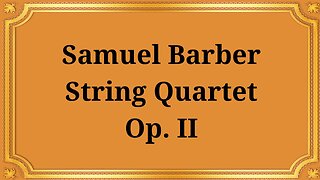Premium Only Content

Wolfgang Amadeus Mozart String Quintet №5 in D major, K 593
#Mozart#Chamber_music#Classical_music#String_Quintet#Musical_composition
Publication date 1936
Pro Arte Quartet with Alfred Hobday, viola
Mozart String Quintet No. 5 in D, K 593, is a beautiful example of Mozart's chamber music. Composed in 1790, the piece is characterized by its elegant melodies, intricate counterpoint, and rich harmonies.
History and Significance of Mozart String Quintet No. 5 in D, K 593
Mozart composed String Quintet No. 5 in D in the summer of 1790, during a period of great productivity in his career. The piece was composed for a wealthy amateur cellist named Franz Anton Hoffmeister, who published it under his own name. The piece was well received by audiences and musicians alike and has since become one of Mozart's most beloved chamber music works.
The significance of String Quintet No. 5 lies in its position as a masterpiece of chamber music. It showcases Mozart's mastery of the genre and his ability to create music that is both elegant and emotionally expressive. The piece is also significant for its influence on later composers, including Schubert and Brahms.
Composition and Characteristics of Mozart String Quintet No. 5 in D, K 593
String Quintet No. 5 is a five-movement piece of music that features two violins, two violas, and a cello. The first movement is in sonata form and is characterized by its elegant melodies and intricate counterpoint. The second movement is a slow and lyrical piece that features a beautiful duet for the two violas. The third movement is a minuet and trio that features a playful dance rhythm, while the fourth movement is a lively and exciting scherzo. The final movement is a rondo that features a lively and memorable theme.
One of the most notable characteristics of String Quintet No. 5 is its use of chromaticism, which is the technique of using notes outside of the key signature to create a sense of tension and release. Mozart uses chromaticism to great effect in this piece, creating moments of emotional intensity and depth.
Another notable characteristic of String Quintet No. 5 is its use of counterpoint. Mozart was a master of counterpoint, and he uses it to great effect in this piece, creating a rich and textured sound that is both intricate and accessible.
Conclusion
Mozart String Quintet No. 5 in D, K 593, is a masterpiece of chamber music that showcases Mozart's mastery of melody, harmony, and counterpoint. Its elegant melodies, intricate counterpoint, and rich harmonies make it a beloved piece of music for both scholars and enthusiasts alike. It is a testament to Mozart's genius and his influence on the classical music tradition, and it remains an enduring masterpiece that continues to inspire and delight listeners around the world.
You have the opportunity to support the channel
https://www.donationalerts.com/r/radsiaral
-
 16:45
16:45
Classical music_Music Inspiration
5 days agoSamuel Barber String Quartet, Op. II
512 -
 LIVE
LIVE
The Officer Tatum
1 hour agoBREAKING: Shooter IDENTIFIED TR*NS , Cracker Barrel CAVES To Pressure + MORE | EP 162
1,521 watching -
 LIVE
LIVE
Matt Kohrs
1 hour agoLIVE! Nvidia Earnings Call || NVDA Stock Reaction
377 watching -

The Quartering
3 hours agoFlag Burning, Free Speech, Church Attack & More With Andrew Wilson
103K220 -
 LIVE
LIVE
The Robert Scott Bell Show
17 hours agoDr. Peter McCullough, Vaccines: Mythology, Ideology, and Reality, Dr. Dan Sullivan, Chiropractic - The RSB Show 8-27-25
63 watching -
 1:21:03
1:21:03
Darkhorse Podcast
3 hours agoThe 291st Evolutionary Lens with Bret Weinstein and Heather Heying
6.24K6 -
 2:34:01
2:34:01
Steven Crowder
3 hours agoMinnesota Catholic School Shooting Update - Shooter & Manifesto
189K269 -
 LIVE
LIVE
Stephen Gardner
40 minutes ago🚨CHICAGO Mayor PISSED as Residents BEG Trump to send National Guard
830 watching -
 LIVE
LIVE
The HotSeat
1 hour agoChristian School Shooting in Minnesota – Faith Under Fire & Prophecy Being Fulfilled
605 watching -
 LIVE
LIVE
Film Threat
16 hours agoPEACEMAKER BLOWS GUNN'S DC! PLUS ALIEN: EARTH AND DEXTER RESURRECTION | Hollywood on the Rocks
73 watching